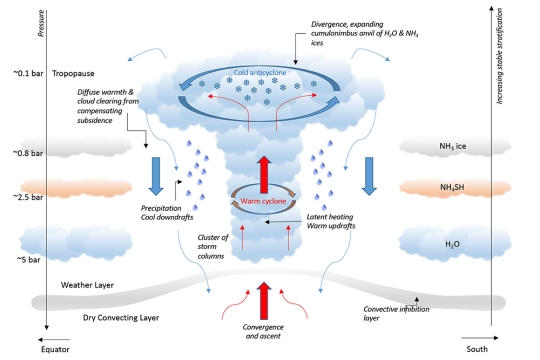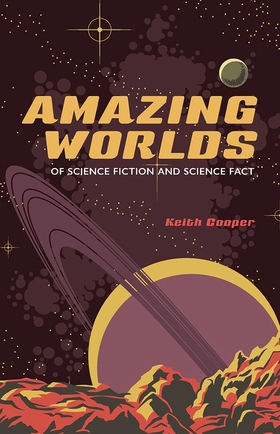Centauri Dreams
Imagining and Planning Interstellar Exploration
A Major Step for the James Webb Space Telescope
The James Webb Space Telescope has been assembled for the first time, meaning its two halves — the spacecraft and the telescope — have been connected, following up earlier testing in which the two parts were temporarily connected by ground wiring. The latter took place almost a year ago, in September of 2018, allowing spacecraft and telescope test teams to begin working together as the process pointed to the physical connection that has now been achieved.
The connection was completed at Northrop Grumman’s facilities in Redondo Beach, California, with the telescope, its mirrors and science instruments, lifted by crane above the sunshield and spacecraft, which had already been combined. With the mechanical connection complete, the next step will be the electrical connection of the two halves and subsequent testng.
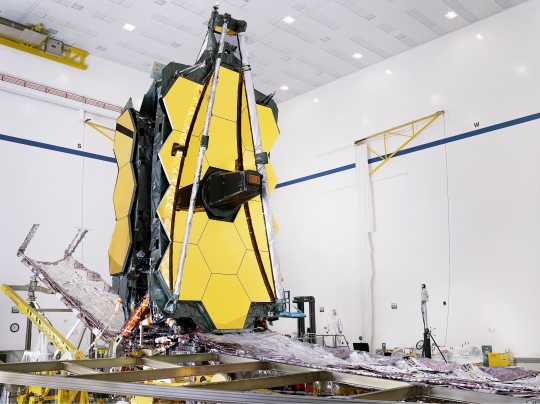
Image: The fully assembled James Webb Space Telescope with its sunshield and unitized pallet structures (UPSs) that fold up around the telescope for launch, are seen partially deployed to an open configuration to enable telescope installation. Credits: NASA/Chris Gunn.
“This is an exciting time to now see all Webb’s parts finally joined together into a single observatory for the very first time,” says Gregory Robinson, the Webb program director at NASA Headquarters in Washington, D.C. “The engineering team has accomplished a huge step forward and soon we will be able to see incredible new views of our amazing universe.”
The next round of testing includes full deployment of the JWST sunshield. Its critical role: To keep the observatory’s mirrors and scientific instruments cold to allow its infrared observations to achieve maximum resolution. The sunshield, layered in five sections, will have one side, facing the Sun, that can reach 383 Kelvin (110 degrees Celsius), while the other side has a modeled minimum temperature of 36 Kelvin, or -237 degrees Celsius. And it’s big, measuring 21.197 m x 14.162 m (this makes it about the size of a tennis court, a fact I throw in for those Centauri Dreams readers who enjoy sports comparisons in relation to space topics).
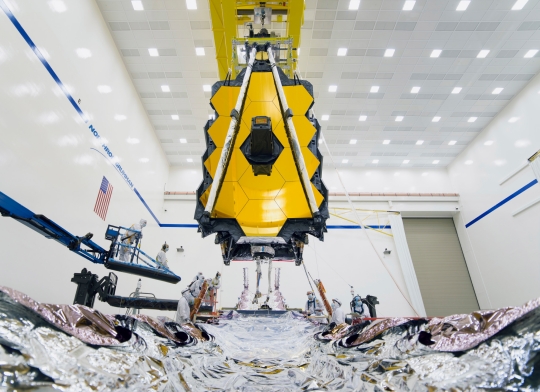
Image: Integration teams carefully guide Webb’s suspended telescope section into place above its Spacecraft Element just prior to integration. Credit: NASA/Chris Gunn.
The sunshield should allow the telescope, once at the L2 Lagrangian point, to cool down below 50 Kelvin (-223 degrees Celsius) by simply radiating its heat into space. This will allow successful functioning of the near-infrared instruments, which include the Near Infrared Camera (NIRCam), the Near InfraRed Spectrograph (NIRSpec) and the Fine Guidance Sensor / Near Infrared Imager and Slitless Spectrograph (FGS/NIRISS) — all of these work at 39 K (-234°C). The Mid-Infrared Instrument (MIRI) will operate at 7 K (-266 degrees Celsius) using a cryocooler system. Thermal stability will allow proper alignment of the primary mirror segments.
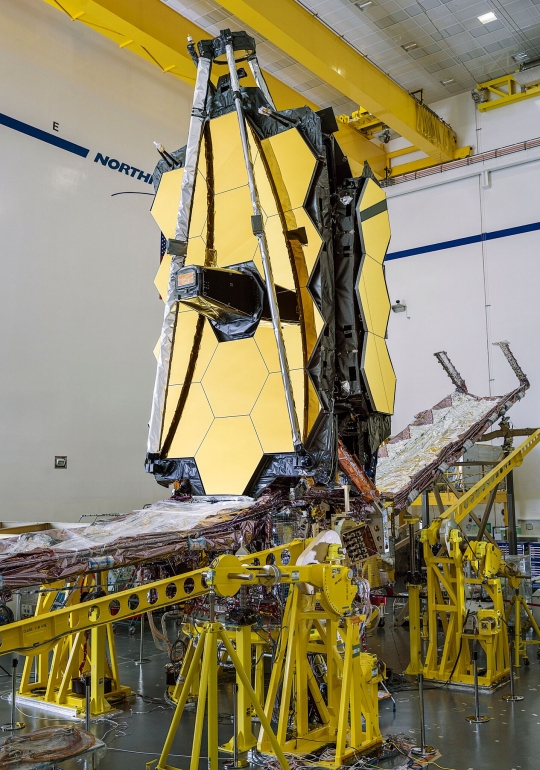
Image: NASA’s James Webb Space Telescope, post-integration, inside Northrop Grumman’s cleanroom facilities in Redondo Beach, California. Credit: NASA/Chris Gunn.
With launch scheduled for 2021, extensive environmental and deployment testing will now be undertaken for the fully assembled observatory. All of the telescope’s major components have gone through rounds of environmental tests including launch stress and vibration, but we now have to put the integrated assembly through its paces. As if launch wasn’t stressful enough, we’ll have to sweat out deployment of the sunshield and the 6.5-meter primary mirror, all destined for Earth-Sun L2, which is far beyond the orbit of the Moon. Plenty of suspense ahead as we tune-up for 2021. Getting this expensive bird in place is going to be a nail-biter.

HR 5183 b: Pushing Radial Velocity Techniques Deeper into a Stellar System
Radial velocity methods for detecting exoplanets keep improving. We’ve gone from the first main sequence star with a planet (51 Pegasi b) in 1995 to over 450 planets detected with RV, a technique that traces minute variations in starlight as a star nudges closer, then further from us as it is tugged by a planet. Radial velocity, then, sees gravitational effects while not directly observing the planet, which may in some cases be studied by its transits or direct imaging.

Image: 51 Pegasi b, also called “Dimidium,” was the first exoplanet discovered orbiting a star like our sun. This groundbreaking find in 1995 confirmed that planets around main sequence stars could exist elsewhere in the universe. Credit: NASA.
Transit methods have accounted for more planets, but radial velocity techniques are increasingly robust and continue to provide breakthroughs. Consider this morning’s news about HR 5183, which is now known to be orbited by a gas giant designated HR 5183 b. Astronomers at the California Planet Search have employed data from Lick Observatory in northern California, the W. M. Keck Observatory in Hawaii and McDonald Observatory in Texas to identify the planet around a star they have been studying since the 1990s. Even now, they do not have data corresponding to a single full orbit of the planet.
Thus the inherent dilemma of radial velocity work: To analyze Doppler data, observations taken over a planet’s entire orbital period are optimal, but as the distance between planet and host star widens, a full orbit can take decades or even centuries. But with data on a timescale of decades, the California Planet Search team identified this one because of its odd orbit. Andrew Howard (Caltech), who leads the effort, points to the unusual nature of its motion:
“This planet spends most of its time loitering in the outer part of its star’s planetary system in this highly eccentric orbit, then it starts to accelerate in and does a slingshot around its star. We detected this slingshot motion. We saw the planet come in and now it’s on its way out. That creates such a distinctive signature that we can be sure that this is a real planet, even though we haven’t seen a complete orbit.”
Just how HR 5183 b got into such an interesting orbit is an intriguing question, one that is most likely answered by gravitational interactions with a planet of roughly the same size. The scenario: One planet is pushed out of the system to become a ‘rogue’ planet without a star, while HR 5183 b is forced into the orbit we observe, one that takes somewhere between 45 to 100 years to complete. Needless to say, we have nothing like this in our Solar System, but the new world reminds us how a system can be shaped by encounters between giant planets.
Moreover, there is an interesting twist here, a possible stellar companion that the authors have identified in the form of HIP 67291, a K-class star on the order of 15,000 AU from HR 5183. At this distance, the companion star is too far away to affect HR 5183 b, but it has to be included in any discussion of this system’s evolution. From the paper:
The extreme eccentricity and decades-long orbital period of HR 5183 b, coupled with the existence of a widely separated, eccentric stellar companion…raise interesting questions about the system’s formation. High eccentricity is a signature of past dynamical interactions (Dawson et al. 2014). Moreover, recent dynamical simulations by Wang et al. (2018) revealed that systems hosting multiple young massive planets, presumably near their formation locations, are likely unstable on Gyr or shorter timescales. Therefore, the HR 5183 system might have initially contained multiple massive planets with moderate eccentricities.
All of which backs the theory of a slingshot effect, with one planet coming close to the other and, in Howard’s words, coming “in like a wrecking ball, knocking anything in its way out of the system.”
We’re also reminded that radial velocity methods are now moving deeper into stellar systems, helping us to learn about planets that do not necessarily transit but leave their signature on the host star’s motion. The paper goes on to point to another system, HR 8799, which contains at least four massive planets whose orbital motion was confirmed by direct imaging.
Planet-planet interactions in such a system could have ejected some planets and transferred angular momentum to the remaining planet(s), pumping their eccentricities. If this is true, the HR 5183 system could be viewed as the “fate” of systems like HR 8799. Dynamical work aiming to distinguish between this and other possible formation scenarios (for example, potential past interactions with HIP 67291) would be an excellent avenue for future studies. It will be interesting to learn whether HR 5183 b represents the eventual evolution of multiple giant planet systems like HR 8799, or if it is in a class all its own.
So radial velocity finds its way into a previously unexplored parameter space, the realm of long-period gas giants on eccentric orbits. Usefully, HR 5183 b is a candidate for future detection through high-contrast imaging and stellar astrometry, which would make it possible to measure its mass directly. The authors believe the planet will be detectable in data from Gaia, ESA’s space observatory designed to use astrometry to measure the positions and motions of stars with the highest precision yet. We’ll be hearing a good deal more about HR 5183 b.
The paper is Blunt et al., “Radial Velocity of an Eccentric Jovian World Orbiting at 18AU,” accepted at The Astronomical Journal (preprint).

Upwelling Oceans: Modeling Exoplanet Habitability
We usually talk about habitability in binary form — either a planet is habitable or it is not, defining the matter with a ‘habitable zone’ in which liquid water could exist on the surface. Earth is, of course, the gold standard, for we haven’t detected life on any other world.
But it is conceivable that there are planets where conditions are more clement than our own, as Stephanie Olson (University of Chicago) has recently pointed out. The work, presented at the just concluded Goldschmidt Geochemistry Congress in Barcelona, models circulatory patterns in oceans, some of which may support abundant life if they exist elsewhere. The emphasis here is not so much on surface ocean currents but upwelling water from deep below. Says Olson:
“We have used an ocean circulation model to identify which planets will have the most efficient upwelling and thus offer particularly hospitable oceans. We found that higher atmospheric density, slower rotation rates, and the presence of continents all yield higher upwelling rates. A further implication is that Earth might not be optimally habitable–and life elsewhere may enjoy a planet that is even more hospitable than our own.”

All this has implications for how we use the term ‘Earth-like,’ and reminds us to be careful, as Olson told a Los Angeles Times interviewer in 2018:
“The phrase Earth-like does not refer to a planet that necessarily resembles modern-day Earth at all… It’s actually a very broad term that encompasses a broad variety of worlds. It includes hazy worlds like the Archean; it includes icy worlds like the ‘snowball Earth’ intervals; it includes anoxic worlds with exclusively microbial ecosystems; it includes worlds with complex and intelligent life; and it includes worlds that we haven’t even seen yet.”
Image: Geophysicist Stephanie Olson. Credit: University of Chicago.
Stephanie Olson makes the case that life has to be far more common than what we can detect at our current stage of technology. An ecosystem beneath the surface of an icy moon may defeat our methods, as could microorganisms deep within a planet’s mantle. So what we need to do, in this scientist’s view, is build our target lists for future study around a subset of planets, those that meet the habitability demands of forms of life that are global, active and detectable. This also builds the list of those worlds for which a non-detection would be the most telling.
In general, our developing models for habitability have tracked our interest in finding atmospheric biosignatures, for we are closing in on the capability of doing this for small, rocky worlds circling nearby M-dwarf stars. The complexities of ocean dynamics have been left out of the picture other than when used as a mechanism for climate regulation or heat transport.
In her conference abstract at the Goldschmidt conference, Olson argues that the implications of circulatory patterns in oceans should be folded into the habitability question. Cycles of ocean upwelling driven by winds can recycle nutrients from the deep ocean back to shallower waters where they can play a role in stimulating photosynthesis. From the abstract:
Photosynthesis,,,provides energy in the form of chemical disequilibrium that sustains life more broadly on our planet. Ocean circulation is thus a first-order control on the productivity and distribution of life on Earth today and throughout our planet’s history. Moreover, ocean circulation patterns, sea ice coverage, and sea-to-air gas exchange kinetics modulate the extent to which biological activity within the ocean is communicated to the atmosphere. The chemical evolution of Earth’s atmosphere has ultimately been an imperfect reflection of the evolution of Earth’s marine biosphere owing to these oceanographic phenomena.
Models of Habitability
Olson’s tool for exploring ocean dynamics on a range of modeled, habitable exoplanets is a global circulation model (GCM) called ROCKE-3D. The software is designed to examine different periods in the evolution of terrestrial-class planets, with the goal of finding what kind of techniques might flag the presence of life in these environments. You can have a look at ROCKE-3D in action in this NASA page on the simulation of planetary climates. Different parameters can be selected on a form to create maps of a number of climate variables.
Below is an example of one of these maps, as created by the ROCKE-3D software.
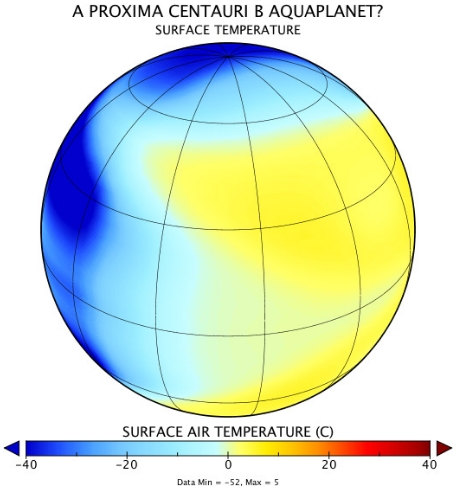
Image: The discovery of the planet Proxima Centauri b orbiting the star closest to Earth has generated much research about whether it has a chance to be habitable. With ROCKE-3D we have imagined Proxima Centauri b as an “aquaplanet” covered by water. Because the planet is close to its star, it may show the same face to the star all the time, as the Moon does to the Earth. If so, the dayside remains a few degrees above freezing (yellow colors). Elsewhere, the ocean is perpetually covered by ice (dark blue colors), except near the equator where winds and ocean currents push sea ice eastward onto the dayside where it breaks up and melts (pale blue to light yellow colors). Credit: NASA Nexus for Exoplanet System Science (NExSS) / NASA Goddard Institute for Space Studies (GISS).
Three-dimensional planetary general circulation models have been used to project climate change into future decades, but have matured to the point that they can probe habitability questions such as how a planet can become habitable under variations in stellar radiation and atmospheric chemistry. The NASA Nexus for Exoplanet System Science (NExSS) effort works on these matters in a cross-disciplinary effort to parse habitability in terms of the factors that make it happen, from host stars to protoplanetary disks and rocky planet atmospheres.
ROCKE-3D stands for Resolving Orbital and Climate Keys of Earth and Extraterrestrial Environments with Dynamics, now developing as a collaborative investigation within NExSS. At NASA GSFC, the Goddard Institute for Space Studies (GISS) developed ROCKE-3D to run global circulation model simulations deploying and manipulating past climates of Earth and other planets by way of analyzing climates and ocean habitats. The idea is to produce model spectra and phase curves for future observations. Let me quote from the GISS website:
Our project uses solar radiation patterns and planetary rotation rates from simulations of spin-orbit dynamical evolution of planets over Solar System history provided by our colleagues at the Columbia Astrobiology Center and at other institutions that are part of our NExSS team. In turn, the synthetic disk-integrated spectra we produce from the GCM will be used as input to a whole planetary system spectral model that emulates observations that candidate future direct imaging exoplanet missions might obtain…
Here you can see the direction of this work. What these teams are trying to do is model what future observatories may see when we become capable of directly imaging rocky exoplanets. We need to learn what kind of signals may be detectable as we allocate precious observing time to those targets most likely to repay the effort. Here theory about the kind of spectral details that life may produce is the foundation for later direct observational data.
Olson’s Oceans
Back to Olson, who wants to fold ocean dynamics into this effort and consider how they may be manifested on habitable exoplanets. Can features of ocean circulation that we cannot observe be inferred from atmospheric properties we can see? Olson’s work is an attempt to link ocean circulation with key planetary parameters, invoking the biological constraints differing ocean habitats may place on worlds around a variety of stars.
We can’t say how this work will develop, but there is the real prospect for the telescope design of future missions — think LUVOIR (Large UV/Optical/IR Surveyor) or HabEx (Habitable Exoplanet Observatory) — to be affected as we learn more about what we need to look for. Adds Olson:
“Our work has been aimed at identifying the exoplanet oceans which have the greatest capacity to host globally abundant and active life. Life in Earth’s oceans depends on upwelling (upward flow) which returns nutrients from the dark depths of the ocean to the sunlit portions of the ocean where photosynthetic life lives. More upwelling means more nutrient resupply, which means more biological activity. These are the conditions we need to look for on exoplanets.”
Immense effort is going into modeling planetary climate and evolution to guide our investigation of habitability. It will be fascinating to watch the trajectory of these studies as we begin to deploy advanced space-based resources to probe for biosignatures. My guess is that we will see early detections of potential biosignatures — these will receive huge press coverage — but we will not find anything that is unambiguous.
That may seem like a letdown when it happens, but ruling out abiotic mechanisms for possible biosignatures is equally a part of global circulation modeling, and this work will take time.

JUICE: Targeting Three Icy Moons
Because Europa Clipper has been on my mind, what with the confirmation of its next mission phase (see Europa Clipper Moves to Next Stage), we need to continue to keep the mission in context. What is playing out is a deepening of our initial reconnaissance of the Jovian system, and the JUICE mission (Jupiter Icy Moons Explorer) is a significant part of that overall effort. The European Space Agency has the spacecraft under development, with Airbus Defence and Space as the primary contractor.
We saw last week that while Europa Clipper will use flybys of Ganymede and Callisto for gravity maneuvers intended to refine its orbit, the latter two moons are not science priorities. JUICE, on the other hand, focuses on all three, each thought to house liquid water beneath the surface. JUICE is slated for a June, 2022 launch, reaching Jupiter in 2029 with the help of five gravity assists along the way, so its operations will overlap with Europa Clipper, the NASA craft launching in 2023. The coming decade will be busy indeed as we journey to and explore these compelling icy targets.
The orbital maneuvers chosen for JUICE are intriguing, for after its first flyby of Europa in 2030, the spacecraft is to enter a high-inclination orbit to study Jupiter’s polar regions and magnetosphere. Repeated flybys of Europa, Ganymede and Callisto are planned, and following a Callisto flyby in 2031, the spacecraft will actually enter orbit around Ganymede, making it the first spacecraft to orbit a moon other than our own. I’m simplifying these complicated orbital maneuvers for the sake of brevity, but the point is that JUICE will greatly expand our datasets on all three moons.
In June of 2019, engineers at Airbus Defence and Space’s site in Toulouse tested the navigation camera that will be essential for radio tracking and position and velocity information of the spacecraft relative to the moon it is currently studying. Given the powerful radiation found near Jupiter, the spacecraft will, like Europa Clipper, be radiation-hardened, allowing it to operate between 200 and 400 kilometers from its targets at closest points of rendezvous. The pointing accuracy demanded of NavCam during fast and close approaches like these is critical to the mission’s success.
The June tests looked at the NavCam engineering model in real sky conditions, the point being to stress the hardware and software interfaces to validate their design, as well as to prepare the image processing and onboard navigation software that JUICE will use to acquire its images. The engineers observed Earth’s own moon and a variety of sky objects included Jupiter itself as part of these tests, running NavCam in ‘imaging mode’ and ‘sky centroiding mode’ as part of fine tuning attitude control software.
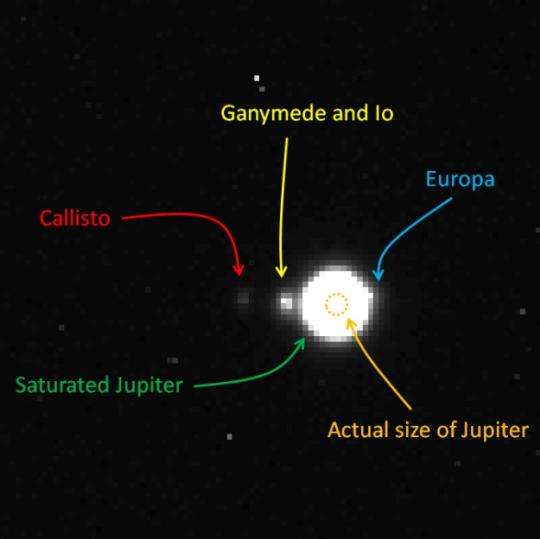
Image: The Navigation Camera (NavCam) of the Jupiter Icy Moons Explorer (JUICE) has been given its first glimpse of the mission’s destination while still on Earth. The camera was mounted to an equatorial mount and pointed towards different targets, including bright stars, Jupiter and its moons in order to exercise its ‘Imaging Mode’ and ‘Stars Centroiding Mode’. The integration time was optimized for capturing the stars and moons acquisition, so Jupiter appears saturated. In this annotated image the size of Jupiter is indicated. Credit & Copyright: Airbus Defence and Space.
“Unsurprisingly, some 640 million kilometres away, the moons of Jupiter are seen only as a mere pixel or two, and Jupiter itself appears saturated in the long exposure images needed to capture both the moons and background stars, but these images are useful to fine-tune our image processing software that will run autonomously onboard the spacecraft,” says Gregory Jonniaux, Vision-Based Navigation expert at Airbus Defence and Space. “It felt particularly meaningful to conduct our tests already on our destination!”

Image: Impressions of how the Jupiter Icy Moons Explorer will see moons Europa (left), Ganymede (middle) and Callisto (right) with its Navigation Camera (NavCam). To generate these images, the NavCam was fed simulated views – based on existing images of the moons – to process realistic views of what can be expected once in the Jupiter system. Credit & copyright: Airbus Defence and Space.
The actual flybys will provide close inspection of surface features on Europa, Ganymede and Callisto. In the suite of tests, NavCam also received simulated views of the three moons in order to process the kind of imagery it will acquire in Jupiter space. NavCam will capture imagery that will be greatly augmented by the high-resolution camera suite that will give us our best views of the icy surfaces below.
By the end of 2019, the test NavCam will be augmented with a full flight representative performance optics assembly that will support onboard tests of the complete spacecraft. Meanwhile, a test version of the spacecraft’s 10.5-m long magnetometer boom developed by SENER in Spain has undergone testing at ESA’s Test Centre in the Netherlands, as part of what ESA is describing as “… the most powerful remote sensing, geophysical, and in situ payload complement ever flown to the outer Solar System.”

Image: Magnetometer boom built for ESA’s mission to Jupiter by European Space Agency. Credit: ESA-G. Porter, CC BY-SA 3.0 IGO.

Going Deep into Jupiter’s Storms
Having just looked at events that may have shaped Jupiter’s core, it seems a good time to note the new Hubble image of the planet, taken on June 27, 2019. A couple of things to focus on in the image below: The vast anticyclonic storm we call the Great Red Spot, about the diameter of the Earth, is evident as it rolls counterclockwise between bands of clouds moving in opposite directions toward it.
We still don’t know why, but the storm itself continues to shrink. Smaller storms show up vividly as white or brown ovals, some of which dissipate within hours, while others may be as long lasting as the Great Red Spot, which has dominated Jupiter’s face for at least 150 years. Note the cyclone showing up south of the Spot, visible as a worm-shaped feature. You can also see other anticyclones, appearing as white ovals.
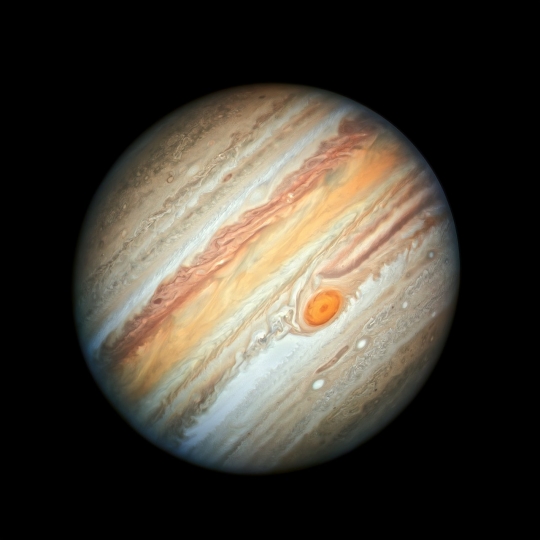
Image: The NASA/ESA Hubble Space Telescope reveals the intricate, detailed beauty of Jupiter’s clouds in this new image taken on 27 June 2019. It features the planet’s trademark Great Red Spot and a more intense colour palette in the clouds swirling in the planet’s turbulent atmosphere than seen in previous years. This image was captured by Hubble’s Wide Field Camera 3, when the planet was 644 million kilometres from Earth. Credit: NASA, ESA, A. Simon (Goddard Space Flight Center), and M.H. Wong (University of California, Berkeley).
But let’s move beyond Hubble. New work on the storm clouds of Jupiter swirling through the planet’s atmospheric belts has just appeared, drawing not only on space-based resources but also a mix of optical and radio telescopes that have gone into recent tracking of their activity. In January of 2017, Australian amateur astronomer Phil Miles observed the bright plume of a storm that was subsequently picked up by observations with the Atacama Large Millimeter/Submillimeter Array (ALMA) in Chile. The latter work was led by UC-Berkeley astronomer Imke de Pater, producing a paper that has been accepted at the Astronomical Journal (citation below).
Things happen quickly enough on Jupiter that we can track them by daily observation, and Hubble images taken a week after the ALMA work showed that what had been a single plume had spawned a second plume and left visible downstream changes in Jupiter’s south equatorial belt. Moreover, four bright spots seen three months earlier in the north equatorial belt had disappeared, while the belt itself had widened as well as changed colors, from a striking white to orange-brown. This may be the result of gas from plumes now depleted of ammonia falling back into the lower atmosphere.
“If these plumes are vigorous and continue to have convective events, they may disturb one of these entire bands over time, though it may take a few months,” says de Pater. “With these observations, we see one plume in progress and the aftereffects of the others.”
The paper posits that plumes like these emerge about 80 kilometers below the cloud tops, in a region where clouds of liquid water droplets are common. Jupiter’s atmosphere is primarily hydrogen and helium, with trace amounts of methane, ammonia, hydrogen sulfide and water. What we’re seeing at the top-most cloud layer, with its brown belts and white zones, is largely made up of ammonia ice. A layer of solid ammonium hydrosulfide particles is found below this in the upper cloud deck.
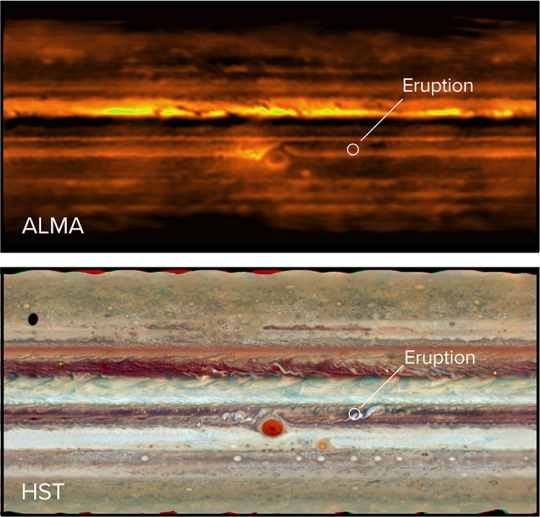
Image: ALMA’s view of Jupiter at radio wavelengths (top) and the Hubble Space Telescope’s view in visible light (bottom). The eruption in the South Equatorial Belt is visible in both images: a dark spot in radio, a bright spot in visible. Credit: ALMA image by Imke de Pater and S. Dagnello; Hubble image courtesy of NASA.
The radio telescopes of ALMA are able to see beneath the upper ammonia clouds that are opaque in visible frequencies, but de Pater’s team also brought data from Hubble, the Very Large Array, the Gemini, Keck and Subaru observatories in Hawaii and the Very Large Telescope (VLT) in Chile into the mix, homing in on the storm seen above as it emerged from the lower cloud levels into the upper ammonia ice clouds.
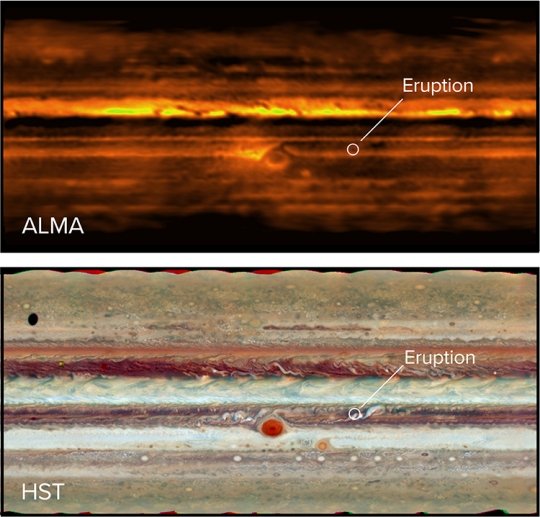
Image: A closeup of the two bright white plumes (center) in the South Equatorial Belt of Jupiter and a large downstream disturbance to their right. Credit: Imke de Pater, UC Berkeley; Robert Sault, University of Melbourne; Chris Moeckel, UC Berkeley; Michael Wong, UC Berkeley; Leigh Fletcher, University of Leicester.
The storm clouds, reaching Jupiter’s tropopause, where the atmosphere is at its coldest, spread out in much the same way as the anvil-shaped formations of thunderstorms we see in Earth’s atmosphere. The ALMA data were sufficient to show that high concentrations of ammonia gas are forced upward during an eruption like this. Convection, the scientists believe, brings both ammonia and water vapor high enough for the water to condense into liquid droplets, releasing heat along the way.
Now we have a plume with enough momentum that, as heat is released from condensing water, can break out above the clouds of the upper deck, where the ammonia will freeze to create the white plume of these images.
“We were really lucky with these data, because they were taken just a few days after amateur astronomers found a bright plume in the South Equatorial Belt,” adds de Pater. “With ALMA, we observed the whole planet and saw that plume, and since ALMA probes below the cloud layers, we could actually see what was going on below the ammonia clouds.”
Image (click to enlarge): An illustration of “moist convection” in Jupiter’s atmosphere shows a rising plume originating about 80 kilometers below the cloud tops, where the pressure is five times that on Earth (5 bar), and rising through regions where water condenses, ammonium hydrosulfide forms and ammonia freezes out as ice, just below the coldest spot in the atmosphere, the tropopause. Credit: Adapted from illustration by Leigh Fletcher, University of Leicester.
This useful analysis was made possible because of simultaneous observations at different wavelengths, in this case homing in on transient events and showing us how the atmosphere at different levels, from cloud tops to deep below, responds to them. This is new ground in the study of Jupiter’s weather, as the paper notes:
These data are the first to characterize the atmosphere below the cloud layers during/following such outbreaks. Aided also by observations ranging from uv to mid-infrared wavelengths, we have shown that the eruptions are consistent with models where energetic plumes are triggered via moist convection at the base of the water cloud. The plumes bring up ammonia gas from the deep atmosphere to high altitudes, where NH3 gas is condensing out and the subsequent dry air is descending in neighboring regions. The cloud tops are cold, as shown by mid-infrared data, indicative of an anticyclonic motion, which causes the storm to break up, as expected from similarities to mesoscale convective storms on Earth. The plume particles reach altitudes as high as the tropopause.
The paper is de Pater et al., “First ALMA Millimeter Wavelength Maps of Jupiter, with a Multi-Wavelength Study of Convection” (preprint).

Giant Jovian Impact Could Explain Juno Data
Impacts seem to have run rampant in the early Solar System, to judge from what we keep uncovering as we survey today’s evidence. The Moon is widely considered to be the result of Earth’s impact with a Mars-class object, while Mercury’s big iron core may show what happens when a larger world is stripped of much of its mantle in another ‘big whack.’ Then there’s Uranus, spinning lopsidedly in the outer system.
We also know that impacts continue to make their mark. They’re shown up on Jupiter at a fairly brisk pace, with Shoemaker-Levy striking the gas giant in 1994, and another evident impact from an asteroid earlier this month, creating a definitive flash.
For that matter, we have a Hubble image from 2009 showing an impact, an expanding spot twice the length of the United States. That one was discovered by Australian amateur astronomer Anthony Wesley. Later observations allowed scientists to estimate the impactor’s diameter at 200 to 500 meters, with an explosion thousands of times more powerful than the Tunguska event in 1908. Juno mission scientist Ravit Helled (University of Zurich) jokes that when planetary scientists lack a solution, they tend to invoke a giant impact. If so, it seems to be an understandable assumption.
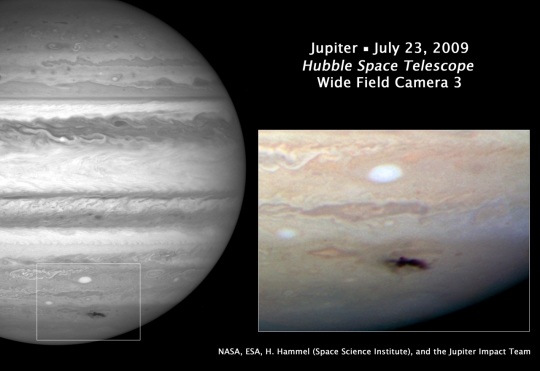
Image: Hubble’s view of the 2009 impact event on Jupiter. Credit: NASA, ESA, and H. Hammel (Space Science Institute, Boulder, Colo.), and the Jupiter Impact Team.
But Helled and colleagues in the National Centre of Competence in Research PlanetS (Bern, Switzerland) aren’t joking when it comes to results from Juno that are forcing them to change their views of Jupiter’s core. The gravity data demand explanation, which may emerge in a massive impact early in the history of Jupiter’s formation:
“Instead of a small compact core as we previously assumed, Jupiter’s core is ‘fuzzy,’” Helled explains. “This means that the core is likely not made of only rocks and ices but is also mixed with hydrogen and helium and there is a gradual transition as opposed to a sharp boundary between the core and the envelope.”
In a paper just published in Nature, Helled and an international team led by Shang-Fei Liu (Sun Yat-sen University in Zhuhai, China) present the results of simulated collisions between an early Jupiter and planetary embryos. They worked with software code developed by PhD student Simon Müller that probed planetary evolution. Particularly puzzling is the thermal evolution of the planet after the impact. Could the diluted core Juno found really persist for billions of years until today?
Giant impacts, the authors argue, are most likely to occur not long after runaway gas accretion. This is when the gravitational effects of the growing planet increase 30-fold in the space of a few million years, destabilizing the orbits of nearby embryos. The team’s simulations show that Jupiter’s gravitational effect on nearby planetary embryos would have been profound, with at least a 40 percent chance that a large embryo would hit Jupiter within the first few million years.
The scientists worked through tens of thousands of simulations to model this effect, and went on to use separate computer code to investigate what these impacts would do to Jupiter’s internal structure. To produce the diluted core we see today, heavy elements in the core and the embryo need to mix with the surrounding gas envelope.
Analyzing heat transport and heavy element mixing, the team finds that it would take an impactor with about 10 times Earth’s mass to stir Jupiter’s core, mixing denser layers with less dense layers above. The team’s 3D models show the effects of a major hit below.
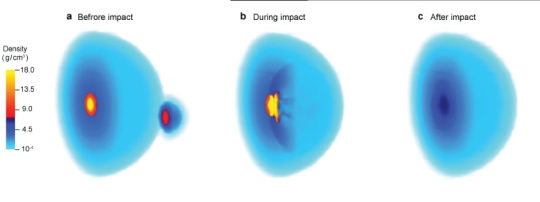
Image: This is Figure 3 from the letter in Nature. Caption: Three-dimensional cutaway snapshots of density distributions during a merger event between a proto-Jupiter with a 10M? rock/ice core and a 10M? impactor. a, Just before the contact. b, The moment of core–impactor contact. c, 10 h after the merger. Owing to impact-induced turbulent mixing, the density of Jupiter’s core decreases by a factor of three after the merger, resulting in an extended diluted core… Credit: Shang-Fei Liu/Sun Yat-sen University.
The authors go on to compute the thermal evolution following the impact of a 10 Earth mass impactor until the present day, a span of 4.56 billion years. There is only one solution that produces a diluted core like that found by Juno. From the paper:
We conclude that Jupiter’s diluted-core structure could be explained by a giant impact event, but only under specific conditions including a head-on collision with a massive planetary embryo, a post-impact central temperature of about 30,000 K or an initial thermal structure created by the accretion shock during the runaway phase. Indeed, the hydrodynamic simulation suggests that most of the impact energy is not deposited in the deep interior, and therefore the central temperature is unlikely to increase substantially, supporting the diluted core solution.
Interestingly, such an impact would demand the collision be head-on, for grazing impacts would not produce the core-density profile that Juno has now measured. Even a grazing embryo of 10 Earth masses, in this scenario, would be disrupted while sinking to the center of the planet. Meanwhile, smaller impactors (1 Earth mass or less) disintegrate in the envelope of the gas giant before they ever reach its center.
How definitive is this impact solution? The paper points out in its conclusion that a gradual accretion of planetesimals along with runaway gas accretion could produce a disrupted core, but the authors question whether this would allow a diluted core to be preserved to the present day. They also note that giant impacts like the one they model here may be producing an observational signature in extrasolar gas giants, in the form of the high metallicity found in some of these worlds. And this is interesting:
Since impacts of planetary embryos are expected to be frequent after a gas giant’s runaway gas accretion phase, such an event with different impact conditions (such as a small impactor or an oblique collision) may have also happened to Saturn, and could in principle explain the differences between the internal structures of Jupiter and Saturn.
Shang-Fei Liu et al., “The formation of Jupiter’s diluted core by a giant impact,” Nature 572 (15 August 2019), pp. 355–357 (abstract).

